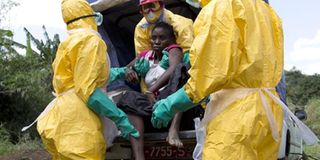Health issues that made headlines in 2015

Health workers assist a patient suspected of having Ebola. FILE PHOTO
Last year, the country dealt with a number of health concerns, including several epidemics that claimed lives, left others infected and caused panic. Except for the ongoing threat of cholera amid the heavy rains that characterised the last quarter of the year, most of the health emergencies were successfully contained and measures put in place to prevent resurgence. We review the effect of the different health conditions and the safeguards in place to ensure we do not see a repeat of this health pattern in 2016.
Cancer
Last year, cancer moved to the top of the health agenda when the disease claimed the lives of three media personalities in less than three months. Veteran journalist Danny Kyazze succumbed to cancer of the bile duct in February. Francis Bbale of Uganda Broadcasting Corporation (UBC) passed away in April after battling cancer of the bladder, and in the same month Rosemary Nankabirwa, one of NTV’S pioneer news anchors, succumbed to adrenocortical carcinoma, cancer of the adrenal gland. It was this that propelled medical officers to come out to advise members of the public to always do routine checks as a way finding out if they bear any health risks.
Response
Dr Fred Okuku, an oncologist at the Uganda Cancer Institute (UCI) says he noticed an increase in the number of individuals visiting the facility for check-ups.
“It is mostly young women who come to check for breast and cervical cancer. The men hardly come probably because they are often busy looking for money but it is also important that they come,” Okuku says.
In 2013, UCI registered about 45,000 cancer-patient visits which increased to 70,000 visits by the end of 2014.
“The number of new patients has increased to almost half of those of the previous year,” he says.
It is estimated that a total of 60,000 people are living with cancer in the country, out of which 20 to 40 per cent seek medical attention at UCI.
Malaria
In July, 10 districts including Gulu, Kitgum, Oyam, Kole and Amuru were hit by malaria. About 22.873 cases were registered.
In September, the number of infections recorded per district remained high with more than 8,000 cases reported weekly. The Ministry of Health confirmed that the outbreak was as a result of the termination of indoor residue spraying, hence increasing infectious bites among individuals.
In December, the number of cases in the Acholi Sub-region was reported to be going up with about 100 people diagnosed with malaria at Ongako Health Centre III in Gulu District.
“We are definitely aware of this problem and are trying to put up measures to ensure that we bring malaria in the region to its knees,” Dr Myers Lugemwa, the head of the malaria control programme at the health ministry says.
Although malaria is still a leading cause of death, Dr Lugemwa says the eradication programme has made tremendous progress.
“The last Malaria Indicator Survey launched this year evaluating the last five years showed that we have been able to reduce the prevalence by over 50 per cent in the country,” he says.
On top of that, Dr Lugemwa says the introduction of the Rapid Diagnostic Tests (RDTs) on the market as well as the distribution of mosquito nets last year have helped reduce the number of malaria cases across the country.
According to Dr Lugemwa, about 22 million nets were distributed until August last year, while 67 per cent of the population is estimated to be sleeping under mosquito nets.
HIV/Aids
In November, more than 700,000 patients on HIV antiretroviral treatment were affected by drug stock outs. The Ministry of Health Drug Stock report prepared by the pharmacy department indicated that the stock levels for adult formulations were low in different government health facilities. Some of the drug combinations that were stated to be in dwindling amounts included; Efavirez 600mg/ Tenefovir /lamivudine and Lopinavir/ritonavir200/50mg.
The situation now
The permanent Secretary Ministry of Health, Dr Asuman Lukwago says that part of this problem has been sorted out.
“We have now zeroed to redistribution whereby excesses have been taken to those facilities that are short of drugs. But we are also working round the clock with Global Fund to acquire funds which we are optimistic to receive in 2017 that we shall inject into stable distribution of drugs,” Dr Lukwago says.
It is estimated that about 1.4 million Ugandans are living with HIV/Aids, with treatment levels for children living with HIV/Aids being as low as 20 per cent and 60 per cent for adults.
Dr Lukwago says much as this is the case, the Ministry has registered that the number of individuals accessing HIV/Aids treatment has increased to 800,000 from 500,000, a number that was recorded about two years back.
“This is because of the adaption of the option B approach where we have scaled up treatment to those people who are the drivers of the epidemic and some of these include mothers who are HIV positive because they transfer infection to their babies.”
Typhoid
The typhoid outbreak was confirmed in February in Kampala, Wakiso and Mukono districts by the Ministry of Health and Kampala Capital City Authority (KCCA). The number of patients was estimated at about 700. There have been other recurrences. In March, 300 typhoid cases were recorded in Maracha District and last month, it was reported that cases of typhoid fever were on the rise in Kasese District.
“Typhoid is something that you cannot easily get rid of but we continuously urge people to observe measures that can help to eliminate the disease such as boiling water and washing fruits before eating,” advised Dr Jane Aceng, Director General of Health Services.
National Water and Sewerage Corporation (NWSC) is also joining the fight by channeling safe piped water to every part of the country.
Ebola
Ebola continued to dominate world headlines at the start of 2015. By March this year, the death toll in West Africa had surpassed 10,000. In the December 9, 2015 World Health Organisation (WHO) Ebola situation report, no confirmed cases of the Ebola Virus Disease (EVD) were reported in the week to December 6.
Back home, when five people from Butiaba Sub-county on the shores of Lake Albert died of a strange illness in August after vomiting blood and passing blood-stained stool, there was panic. Seven samples from the victims were sent to the Uganda Virus Research Institute and the results were negative for Ebola virus, Marburg and Congo haemorrhagic fever. There have been other related scares but the samples from the victims have always turned out negative.
How prepared is Uganda for Ebola attack?
Dr Aceng said the country is ready to tackle any epidemic that surfaces.
“When the outbreak blew out of proportion in West Africa, one of the recommendations from WHO was that every country should develop a preparedness plan and have it ready at any one time. It is what we have been implementing for some time now,” Aceng says.
eoluka @ug.nationmedia.com




